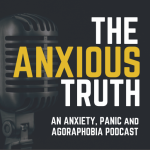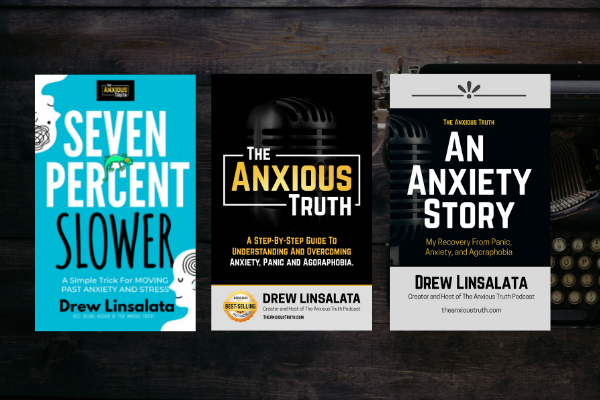I’ve written three books on anxiety and anxiety recovery (so far). Check them out. I’m proud of the fact that they are being read by tens of thousands of people around the world.
Anxiety Recovery Skills
Part of executing a successful anxiety recovery plan is learning some new skills, then practicing them often. These are skills you need to improve as part of changing the way you react to anxiety, panic and fear. Learning these things and taking the time to get better at them will help move you forward in your recovery.
Want to bring this tutorial with you on your phone or tablet? Download it in MP3 format here.
Relaxation, Breathing, and Selective Focus During Anxiety And Panic
HOW DO I RELAX, BREATHE, AND FOCUS????
This video will take you through the basics of what it looks like and feels like when you surrender to anxiety or panic. Instead of fighting and fleeing, this is how we relax into the fear, experience it, and let it pass. This is how we learn that we do not have to fear our anxiety and the sensations that come along with it. The basics are relaxing of your body, breathing into your belly, and focusing on your breath rather than on the symptoms and thoughts. This is a difficult skill to learn, and it will NOT make your anxiety go away instantly.
Please do not use is a calming tool or an escape tool to make your panic attacks end. Use it as a LEARNING tool. Understand that even if you did none of this, your panic attacks would end. This is critical!
Diaphragmatic Breathing - Proper Breathing Technique To Avoid Hyperventilation
This video from the University of Michigan is an excellent, simple tutorial that will teach you how to breathe into your belly without puffing up your chest or trying to “fill” your lugs with air. It will teach you how to exhale for longer than your inhale, which will keep you from over-breathing, or hyperventilating. I’ve chosen this video specifically because it is rather dry and somewhat boring. It teaches the mechanics of proper breathing without confusing the issue with extraneous concepts. Your job is simply to learn the basic skill of diaphragmatic breathing and to practice it often so that it can be used as part of your release, relax, breathe and focus reaction when feeling an anxiety spike or a panic attack. Do not get caught up in the significance of your breath or what it means. This is purely mechanics, so stick to the basics.
Progressive Muscle Relaxation
Learning to identify tension in your muscles, then to release it, is one of the most useful skills you can learn and develop as part of your recovery plan. Many people talk about an almost involuntary bodily tension or stiffness that comes with periods of high anxiety or panic. This is quite common and normal, but contrary to popular opinion, this can be addressed. You are not doomed to become tense and stuff when anxious. This is not totally out of your control.
This is a very basic exercise designed teach you how to identify what muscle tension feels like, and what it feels like to release it. You will not be good at this right away, but it is well worth your time to practice this a few times every day in order to improve your ability to release tension when required. This is an important part of building your new “non-reaction” to anxiety, fear and panic.
Insight Timer – https://insighttimer.com
Insight Timer claims to offer the largest library of free guided meditations on Earth. You can use the free version, and I even have several free guided meditations on the app.
Calm – https://calm.com
Calm’s mission is to make the world happier and healthier. Calm is a meditation, sleep and relaxation app, available in both the App Store and Google Play store. We are dedicated to introducing our world-wide Calm Community to the amazing benefits of mindfulness.
HeadSpace – https://headspace.com
Headspace has one mission: to improve the health and happiness of the world. You can try Headspace for yourself and learn the essentials of meditation and mindfulness with our free Basics course.
Meditation and Meditation Apps
Meditation. I talk about it all the time in the podcast and on my social media. Why? When I talk about meditation, I’m talking about the skill and practice of selective focus and attention. When we learn to meditate, we learn to focus on one thing – usually our breath. We learn this so that we may experience thoughts, feelings, and sensations, without building stories on top of them or reacting to them. Meditation at it’s foundation teaches us that we can choose where to place our attention. We are not merely corks being tossed about in the ocean by powers beyond our control. Our thoughts and our bodies do not have to rule us. We can learn to experience our own minds and bodies from a position of equanimity.
I’m asked often about apps that might be useful in learning meditation and practicing meditation. While ultimately our goal is to be able to meditate in silence – being alone with our thoughts (yes, this is scary) – many people do find the use of meditation apps helpful when starting out. I have no official position on which app is the best. I use Insight Timer more than any other now, and I’ve even recorded several free guided meditations on that app, but they’re all good in my opinion. It’s personal preference.
Subscribe To Get Updates
If you’d like to get updates on my books, podcasts, or other useful anxiety recovery tools and resources, subscribe to my update list. It’s very low volume and I promise to NEVER share your information with anyone else for any amount of money.

Subscribe To My Newsletter
Get notified when I publish new episodes! Get book updates, helpful information, inspiration and encouragement you can use in your recovery plan.
I promise to never spam you and NEVER sell or share your information with any third parties. Unsubscribe at any time.
Featured photo by Daniel Mingook Kim on Unsplash
